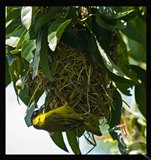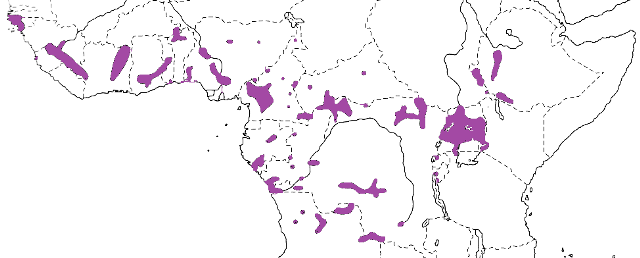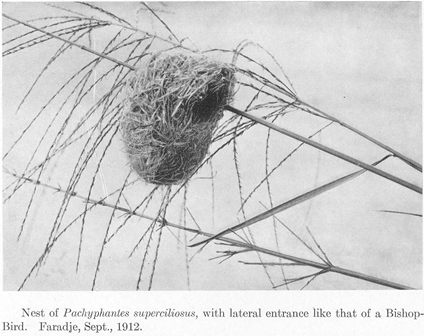Weaver species
Choose different species from drop-down list and press 'Go' button. See Full species list.Compact Weaver Pachyphantes superciliosus
IUCN: Least concern Discovery: 070Categories: Brachycope & Pachyphantes,
News items about species
Discovery
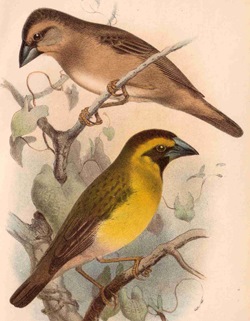
female, figure from Sharpe (1890) 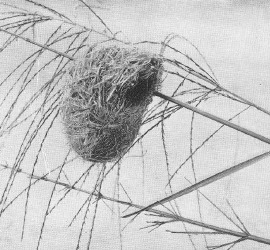
figure from Chapin (1917) 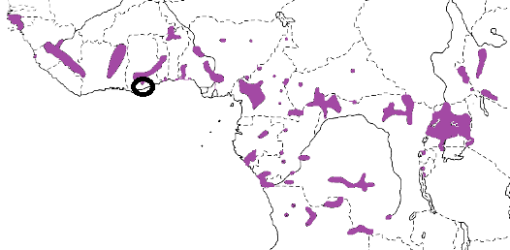
distribution, type locality circled IntroductionThe Compact Weaver was formally described by George Ernest Shelley, an English geologist and ornithologist.Shelley had 2 specimens of the Compact Weaver. An adult female specimen was donated to Sharpe's collection by entomologist William Wilson Saunders, and this specimen is now in the British Museum. The second specimen was a non-breeding bird collected in Accra, by Shelley who visited Ghana from mid January to March 1872 to collect birds. The first illustration of the Compact Weaver was published in Sharpe (1890) of the two type specimens, a non-breeding adult and a female. The next illustration relating to this species was a photo of its nest published in Chapin (1917). The breeding male was first illustrated by Bannerman (1949). Scientific citationHyphantornis superciliosus Shelley 1873, Ibis, p.140 Accra, Gold Coast.Meaning of namessuperciliosus, Latin: superciliosus, eyebrowed (refers to eyebrow of breeding female).First English nameBuff-browed Weaver-bird (Layard 1884).Alternate namesOmo River Compact Weaver. (Origin of name "Compact Weaver", see below).CollectorW Wilson Saunders and George Ernest Shelley.Date collectedMarch 1872.Locality collectedAccra, Ghana.Type specimensThere is a type specimen in the British Museum (BM 1877.7.11.227).Origin of name "Compact Weaver" (8 Feb 2016)The first English name given to this species was Buff-browed Weaver-bird (see above). The next name given was Compact Weaver by Shelley (1905), without hinting as to the reason for the name.The genus gives the most likely clue. Pachyphantes was introduced by Shelley (1896), without description, and this name means: (Greek) pakhus, thick; huphantes, a weaver. So when Shelly gave English names to African birds in 1905, he must have translated Pachyphantes to thick weaver, or rather Compact Weaver. The nest of this species was not known to Shelley in 1905, so the English name would not have referred to the "compact"-like nest of this bird. |
The above is based on Weaver Wednesday 2, a weekly series about the discovery of each weaver species.
This species text first appeared as
Weaver Wednesday [187] - Discovery [70]: Compact Weaver on 2016-01-13
1. Basic biology
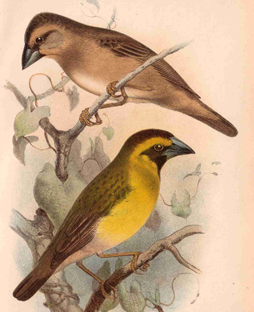
female, figure from Sharpe (1890) 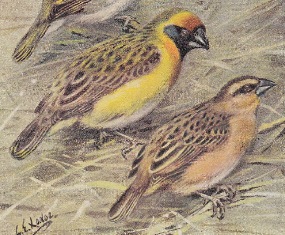
figure from Bannerman (1949) The Compact Weaver is stocky and short-tailed, with a heavy bill. The male has a yellow crown (figure above left) and its dark green upperparts distinguish it from other 'masked' weavers. The female has the top of the head dark (figure above right), separated from the mask by a broad yellow stripe. Non-breeding adults are brownish. A dull coloured female moulting into bright plumage is unique in the Ploceidae family. Distribution.
The Compact Weaver is found in widely disjoint populations across West Africa from Senegal as far east as Ethiopia and western Kenya, and south to northern Angola (with one record from Zambia). It has no subspecies.
Habitat.
The Compact Weaver occurs singly, in pairs, or in small groups. It is found in grassland or grassy savanna while breeding, and more wooded areas the rest of the year. It also occurs in thickets, scattered bush, forest edges, forest clearings, and coffee plantations.
Food. The Compact Weaver feeds on grass seeds and arthropods. The following have been recorded: insects, spiders, caterpillars, seeds and berries. In Ivory Coast, its diet was estimated at roughly 90% seeds and 10% arthropods. Breeding. The Compact Weaver is monogamous. Its nest is distinctive, with a side entrance, being similar to that of the Thick-billed Weaver. The nest is attached to tall grass stems. This species is not generally colonial and pairs occupy a territory with one nest, but sometimes the male builds a second roosting nest nearby. The male probably narrows the entrance of breeding nests but little has been published about nest building in this species. 3-4 eggs are laid. The eggs are plain blue-grey, or they are white, grey or pale bluish-green with fine brown stipples and smears. Nothing more is known about its breeding ecology. |
The above is based on Weaver Wednesday, a weekly series about weaver species.
This species text first appeared as
Weaver Wednesday [9]: Compact Weaver on 2012-08-15
2. Breeding facts
| Pair bond Monogamous Breeding season Aug-Oct in W Africa (from Sierra Leone E to Nigeria), Jan-Feb in Gabon, and Jul-Sept in PRCongo; May-Jun and also Feb and Aug-Oct in Uganda; regional differences in DRCongo, Sept-Nov in Uele region, Feb-Apr in Kwilu area Nest site attached 1.4-2.8 m above ground to vertical grass stems, tops of supporting grasses stripped of seeds (and often nipped off) Nest building no information Colony size nests sometimes within 10 m of each other Clutch size 3-4 eggs Egg colour white, grey or pale bluish-green with fine brown stipples and smears, or plain blue-grey or coffee-coloured Egg size average size of six eggs 18.8 x 13.2 mm (Sierra Leone) Incubation no information Chicks and nestling period no information |
Breeding information based on Handbook of the Birds of the World, Vol. 15.
3. Photos of Weaver Nests
 Vm 7114 | 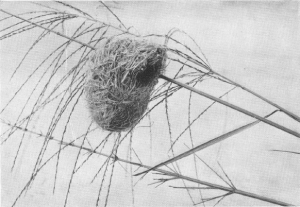 Vm 5771 |
Thumb-nails of most recent PHOWN records - click on one to see its full record
See all PHOWN records for this species here.
PHOWN (Photos of Weaver Nests) provides valuable info on breeding distribution and colony sizes of weavers.
You can contribute by registering and submitting photos at Virtual Museum webpage.
4. Breeding distribution
Google map showing distribution (For species with small ranges you need to zoom in at the correct area to see the range):
yellow blob - range of weaver species; read more about this here.
![]() - PHOWN records with photos
- PHOWN records with photos
![]() - PHOWN records with no photos (Nest Record Cards, other records)
- PHOWN records with no photos (Nest Record Cards, other records)
![]() - Birdpix records
- Birdpix records
![]() - comments on out of range records, or interesting records
- comments on out of range records, or interesting records
![]() - type locality
- type locality
CLICK on the marker on the map to see individual record details.
5. Range changes
Not South African speciesThe above is based on Weaver Wednesday 3, a weekly series about range changes in South African weaver species.
This species text first appeared as
n/a








